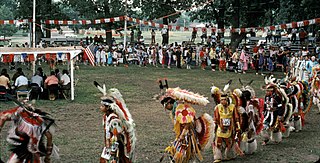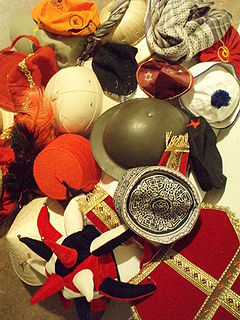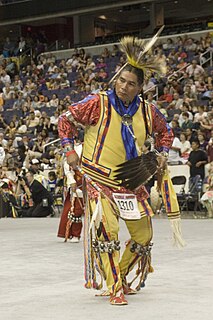
Irish dance is a group of traditional dance forms originating from Ireland, encompassing dancing both solo and in groups, and dancing for social, competitive, and performance purposes. Irish dance in its current form developed from various influences such as Native Irish dance, French quadrilles and English country dancing. Dance was taught by "travelling dance masters" across Ireland in the 17th-18th century, and separate dance forms developed according to regional practice and differing purposes. Irish dance became a significant part of Irish culture, particularly for Irish nationalist movements. From the early 20th century, a number of organisations promoted and codified the various forms of dance, creating competitive structures and standardised styles.

A skirt is the lower part of a dress/gown or a separate outer garment that covers a person from the waist downwards.

A pow wow is a social gathering held by many different Native American communities. A modern pow wow is a specific type of event for Native American people to meet and dance, sing, socialize, and honor their cultures. Pow wows may be private or public. There is generally a dancing competition, with many different types of traditional dances, music and regalia, often with significant prize money awarded. Pow wows vary in length from a one-day event, to major pow wows called for a special occasion which can be up to one week long.

Hula is a Polynesian dance form accompanied by chant (oli) or song. It was developed in the Hawaiian Islands by the Polynesians who originally settled there. The hula dramatizes or portrays the words of the oli or mele in a visual dance form.
Clothing in India changes depending on the different ethnicity, geography, climate, and cultural traditions of the people of each region of India. Historically, male and female clothing has evolved from simple garments like kaupina, langota, dhoti, lungi, sari, gamcha, and loincloths to cover the body into elaborate costumes not only used in daily wear, but also on festive occasions, as well as rituals and dance performances. In urban areas, western clothing is common and uniformly worn by people of all social levels. India also has a great diversity in terms of weaves, fibers, colours, and material of clothing. Sometimes, color codes are followed in clothing based on the religion and ritual concerned. The clothing in India also encompasses the wide variety of Indian embroidery, prints, handwork, embellishment, styles of wearing clothes. A wide mix of Indian traditional clothing and western styles can be seen in India.

The Pend d’Oreille, also known as the Kalispel, are Indigenous peoples of the Northwest Plateau. Today many of them live in Montana and eastern Washington. The Kalispel peoples referred to their primary tribal range as Kaniksu.
The traditional culture of Samoa is a communal way of life based on Fa'a Samoa, the unique socio-political culture. In Samoan culture, most activities are done together. The traditional living quarters, or fale (houses), contain no walls and up to 20 people may sleep on the ground in the same fale. During the day, the fale is used for chatting and relaxing. One's family is viewed as an integral part of a person's life. The aiga or extended family lives and works together. Elders in the family are greatly respected and hold the highest status, and this may be seen at a traditional Sunday umu.

A ball gown, ballgown or gown is a type of evening gown worn to a ball or a formal event. Most versions are cut off the shoulder with a low décolletage, exposed arms, and long bouffant styled skirts. Such gowns are typically worn with a stole, cape or cloak in lieu of a coat, couture or vintage jewelry and opera-length gloves. Where "state decorations" are to be worn, they are on a bow pinned to the chest, and married women wear a tiara if they have one. Although artificial fabrics are now sometimes used, the most common fabrics are satin, silk, taffeta and velvet with trimmings of lace, pearls, sequins, embroidery, ruffles, ribbons, rosettes and ruching.

Fancy dance, Pan-Indian dancing, Fancy Feather or Fancy War Dance is a style of dance some believe was originally created by members of the Ponca tribe in the 1920s and 1930s, in an attempt to preserve their culture and religion. It is loosely based on the War dance. Fancy dance was considered appropriate to be performed for visitors to reservations and at "Wild West" shows. But today, fancy dancers can be seen at many powwows across the nation and even the world.

The Crow Fair was created in 1904 by Crow leaders and an Indian government agent to present the Crow Tribe of Indians as culturally distinct and modern peoples, in an entrepreneurial venue. It welcomes all Native American tribes of the Great Plains to its festivities, functioning as a "giant family reunion under the Big Sky." Indeed, it is currently the largest Northern Native American gathering, attracting nearly 45,000 spectators and participants. Crow Fair is "the teepee capital of the world, over 1,500 teepees in a giant campground," according to 2011 Crow Fair General Manager Austin Little Light.

War bonnets are feathered headgear traditionally worn by male leaders of the American Plains Indians Nations who have earned a place of great respect in their tribe. Originally they were sometimes worn into battle, but they are now primarily used for ceremonial occasions. In the Native American and First Nations communities that traditionally have these items of regalia, they are seen as items of great spiritual and political importance, only to be worn by those who have earned the right and honour through formal recognition by their people.

The Stomp Dance is performed by various Eastern Woodland tribes and Native American communities, including the Muscogee, Yuchi, Cherokee, Chickasaw, Choctaw, Delaware, Miami, Caddo, Tuscarora, Ottawa, Quapaw, Peoria, Shawnee, Seminole, Natchez, and Seneca-Cayuga tribes. Stomp Dance communities are active in North Carolina, Oklahoma, Alabama, Mississippi, and Florida.
Jingle dress is a First Nations and Native American women's pow wow regalia and dance. North Central College associate professor Matthew Krystal notes, in his book, Indigenous Dance and Dancing Indian: Contested Representation in the Global Era, that "Whereas men's styles offer Grass Dance as a healing themed dance, women may select Jingle Dress Dance." The regalia worn for the dance is a jingle dress, which includes ornamentation with multiple rows of metal, such as cones, that create a jingling sound as the dancer moves.

Hopi katsina figures, also known as kachina dolls, are figures carved, typically from cottonwood root, by Hopi people to instruct young girls and new brides about katsinas or katsinam, the immortal beings that bring rain, control other aspects of the natural world and society, and act as messengers between humans and the spirit world.
In English, bustle usually refers to a type of framework used to expand the fullness or support the drapery of the back of a woman's dress, popular during the mid-to-late 19th century.

Headgear, headwear or headdress is the name given to any element of clothing which is worn on one's head.

Belly dance, also referred to as Arabic dance is an expressionist type of dance that originated in Egypt and that emphasizes complex movements of the torso. It has evolved to take many different forms depending on the country and region, both in costume and dance style; with Egyptian style and its famous traditional rhymes being the most common worldwide having many schools around the globe practicing it.

The grass dance or Omaha dance is a style of modern Native American men's pow wow dancing originating in the warrior societies on the Northern Great Plains. Unlike most forms of pow wow dancing, the grass dance regalia generally has no feathers besides the occasional roach feather. The regalia consists of brightly colored fringe made of either yarn, broadcloth, or ribbon.

The Straight Dance, also known as Southern Straight Dance or Southern Traditional, is a style of Native American pow wow dancing. The dance recounts the story of hunting or war parties searching for the enemy.

Mankind has been fascinated by the golden eagle as early as the beginning of recorded history. Most early-recorded cultures regarded the golden eagle with reverence. Only after the Industrial Revolution, when sport-hunting became widespread and commercial stock farming became internationally common, did humans started to widely regard golden eagles as a threat to their livelihoods. This period also brought about the firearm and industrialized poisons, which made it easy for humans to kill the evasive and powerful birds. The following are various reportages of the significance of eagles, many likely pertaining to the golden eagles, in early cultures and older religions as well as national and military insignias.
















